4.4 Wave behaviour
Essential Idea:
Waves interact with media and each other in a number of ways that can be unexpected and useful
Understandings:
- Reflection and refraction
- Snell’s law, critical angle and total internal reflection
- Diffraction through a single-slit and around objects
- Interference patterns
- Double-slit interference
- Path difference
Applications and Skills:
- Sketching and interpreting incident, reflected and transmitted waves at boundaries between media
- Solving problems involving reflection at a plane interface
- Solving problems involving Snell’s law, critical angle and total internal reflection
- Determining refractive index experimentally
- Qualitatively describing the diffraction pattern formed when plane waves are incident normally on a single-slit
- Quantitatively describing double-slit interference intensity patterns
Data booklet reference:
- \(\frac{n_1}{n_2}=\frac{sin\theta _2}{sin\theta _1}=\frac{v_2}{v_1}\)
- \(s=\frac{\lambda D}{d}\)
- Constructive interference: path difference = nλ
- Destructive interference: path difference = \((n+\frac{1}{2})\lambda \)
REFRACTION
- When a ray of light passing from one medium to another medium frequency and phase do not change while wavelength and velocity changes.
- Twinkling of stars, appearance of sun before actual sunrise and after actual sunset etc. are due to atmospheric refraction.
LAWS OF REFRACTION
- Snell’s Law : When a light ray is incident on a surface separating two transparent media, the ray bends at the time of changing the medium.
 ,
, - The incident ray, the normal and the refracted ray at the interface all lie in the same plane.
REFRACTIVE INDEX OF THE MEDIUM





- For three mediums 1, 2 and 3 due to successive refraction.

- For two mediums, n1 and n2 are refractive indices with respect to vacuum, the incident and emergent rays are parallel then
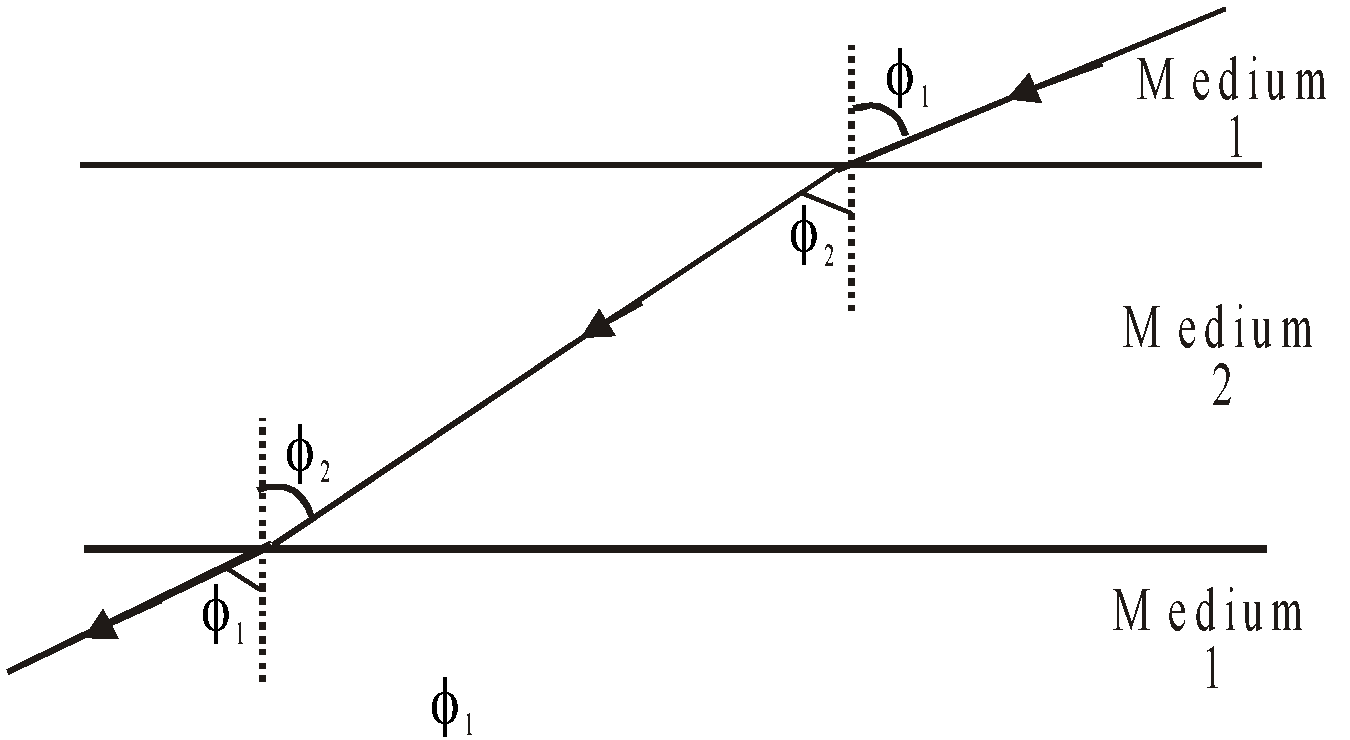
- Nature of the medium
- Wavelength
- Temperature of the medium-with increase in temperature, refractive index of medium decreases.
TRANSMISSION OF WAVE
- The equation of the wave refracted or transmitted to the next medium is given by : y = A´´ sin
 . This is independent of the nature (rarer/denser) of the medium. The wave is not inverted.
. This is independent of the nature (rarer/denser) of the medium. The wave is not inverted. - The amplitude (A´´) of the transmitted wave is less than that (A) of the incident wave.
- The angular frequency remains unchanged. However the wave number changes. Note that the phase of the transmitted wave is
 and that of the incident wave is (ωt – kx).
and that of the incident wave is (ωt – kx). - The compression or rarefaction are transmitted as such and same is the case with the crest or trough.
- If second medium is denser, in comparison to first medium (i.e. μ2 > μ1), then from Snell’s law
- If second medium is rarer in comparison to first medium, then from Snell’s law
- No change in wave number k occurs on reflection.
WAVE Behaviour
WAVEFRONT
- Spherical wavefront : A spherical wavefront is produced by a point source of light. This is because the locus of all such points which are equidistant from the point source will be a sphere. Spherical wavefronts are further divided into two headings: (i) converging spherical and (ii) diverging spherical wavefront.
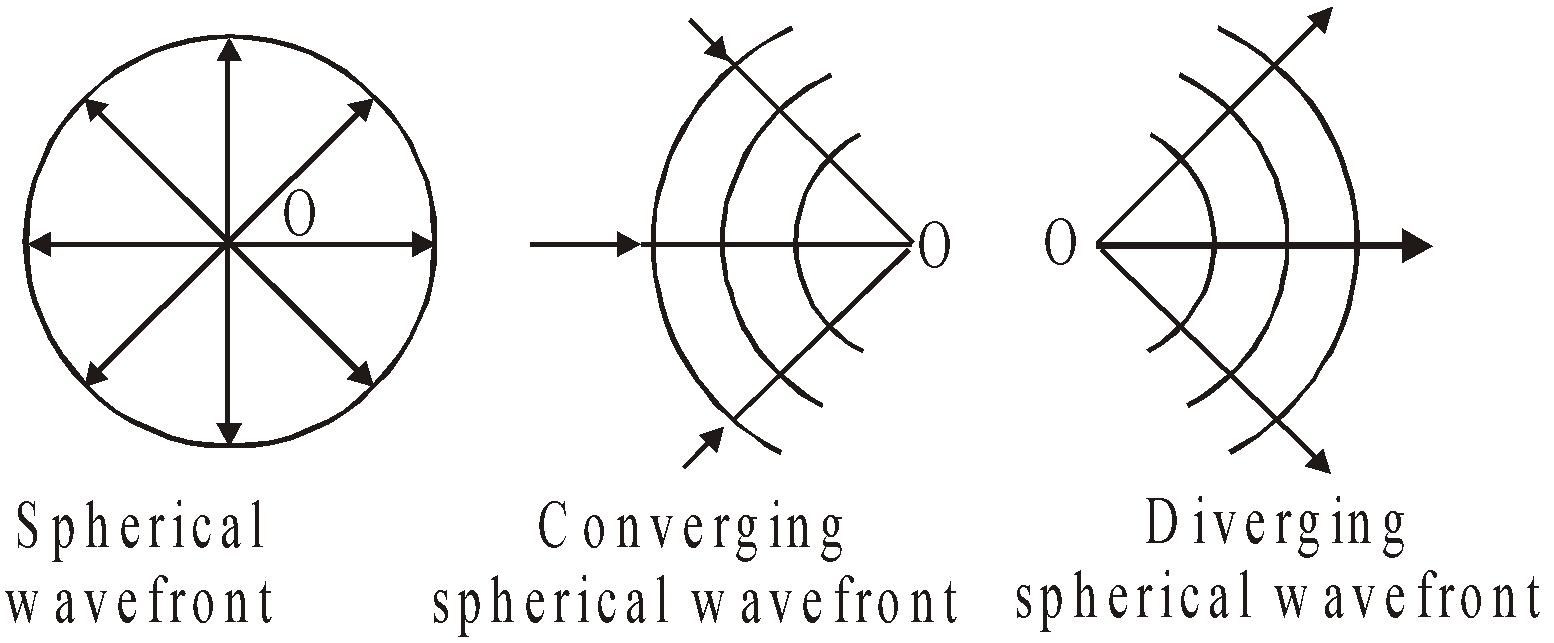
- Cylindrical wavefront : When the source of light is linear in shape such as a slit, the cylindrical wavefront is produced. This is because all the points equidistant from a line source lie on the surface of a cylinder.
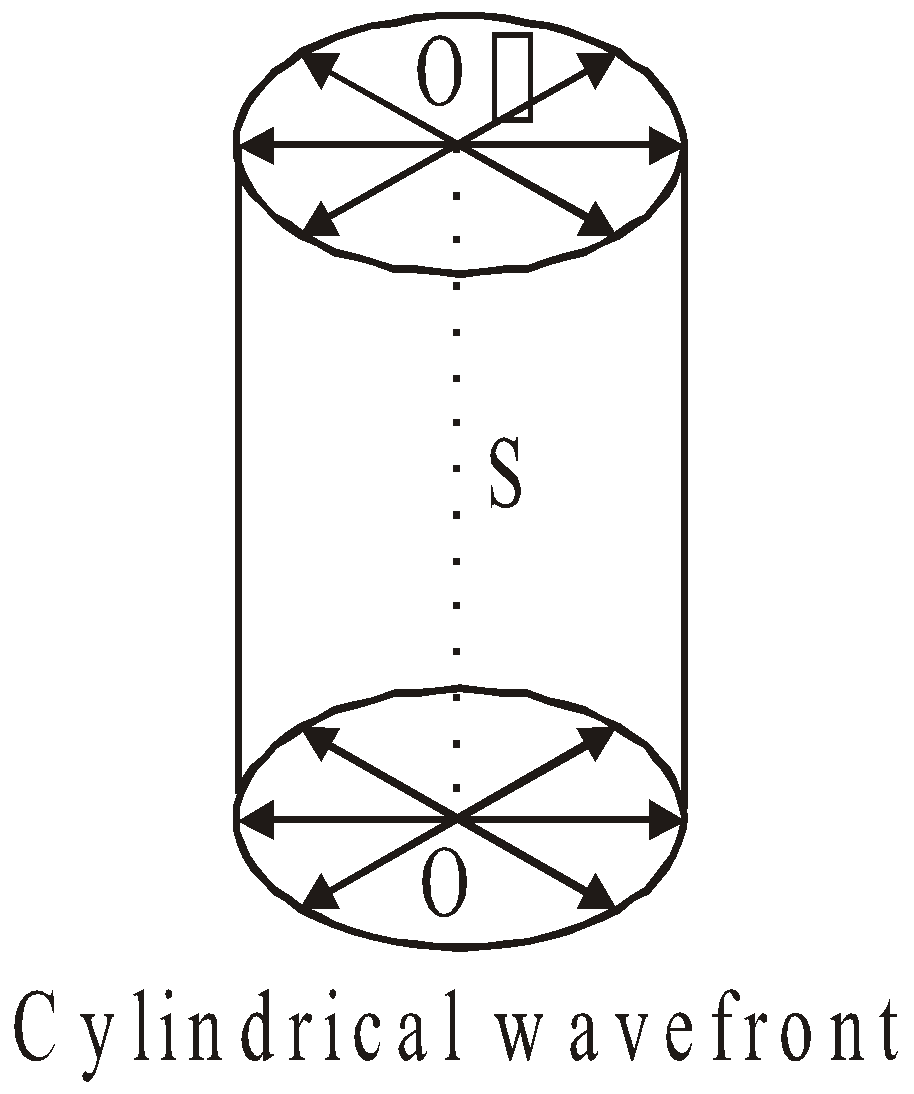
- Plane wavefront : A small part of a spherical or cylindrical wavefront due to a distant source will appear plane and hence it is called plane wave-front. The wavefront of parallel rays is a plane wavefront.
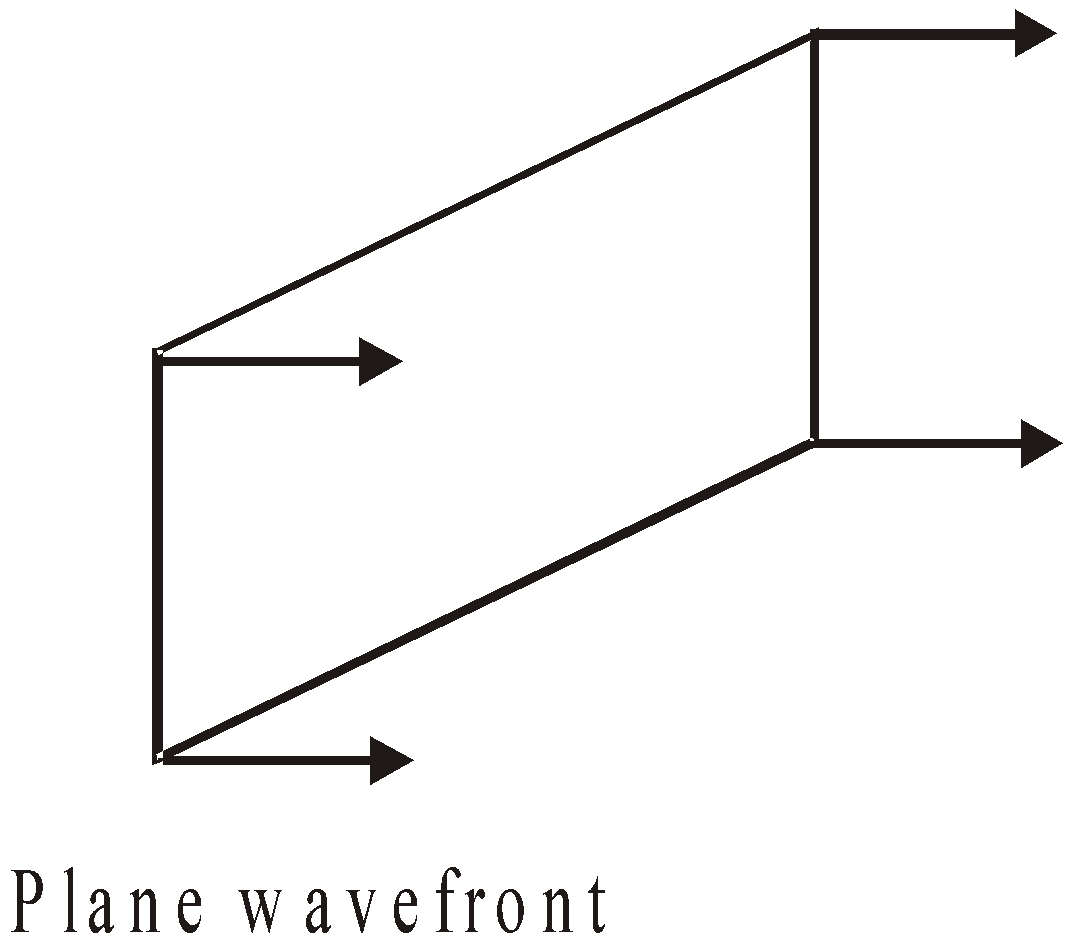
HUYGENS WAVE THEORY
- Each point source of light is a centre of disturbance from which waves spread in all directions.
- Each point on primary wavelets acts as a new source of disturbance and produces secondary wavelets which travel in space with the speed of light.
- The forward envelope of the secondary wavelets at any instant gives the new wavefront.
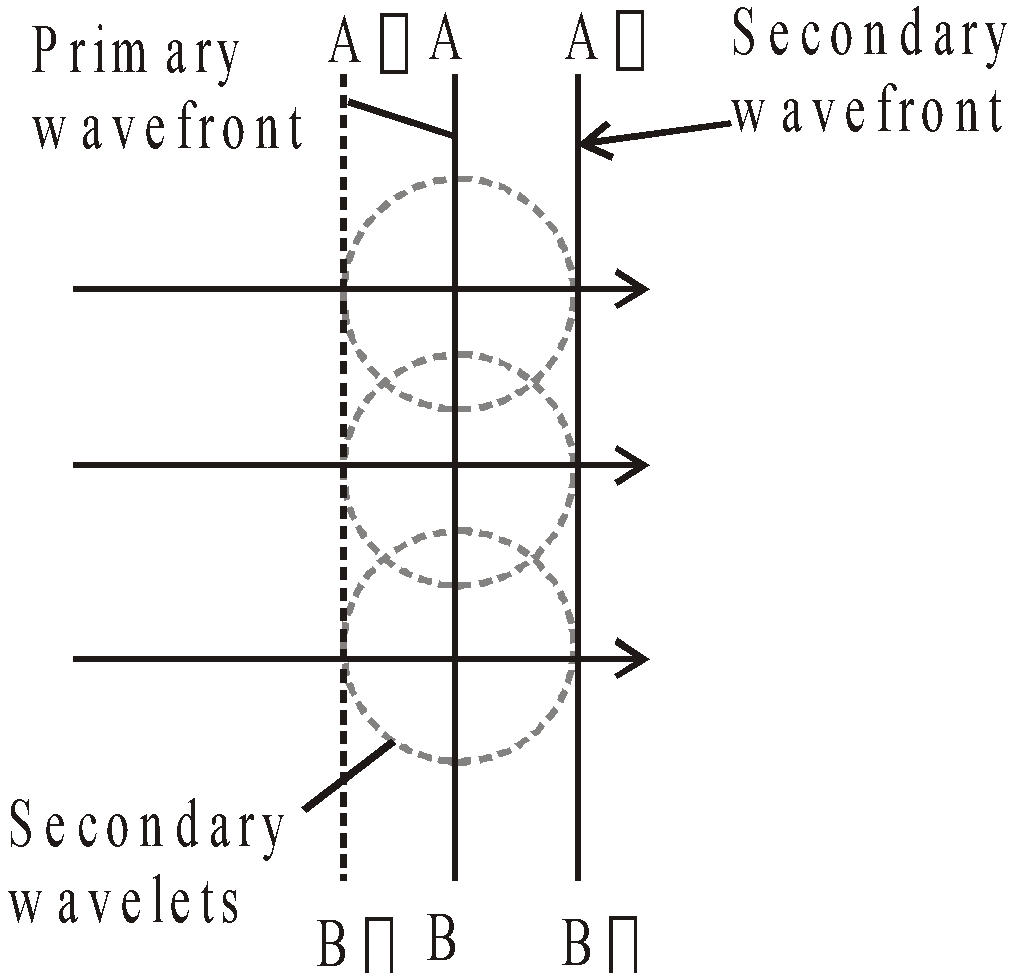
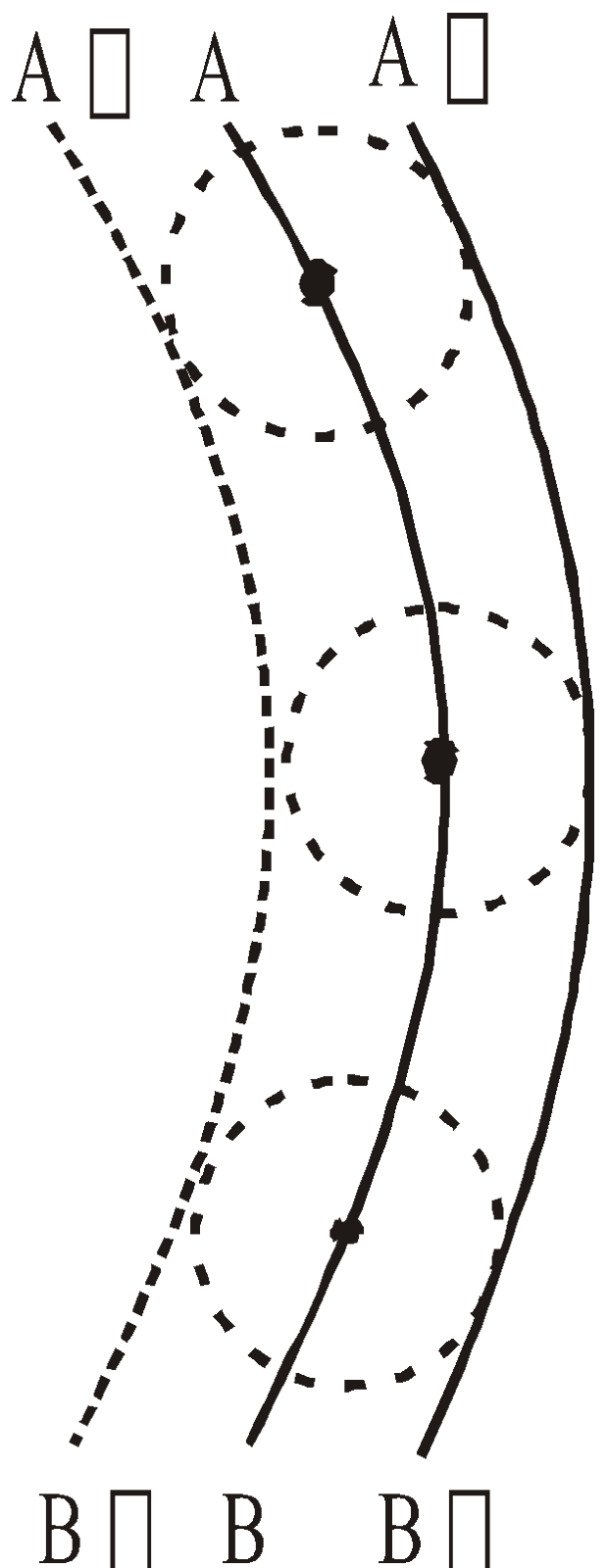
- In a homogeneous medium the wavefront is always perpendicular to the direction of wave propagation.
DRAWBACKS OF HUYGENS WAVE THEORY
- This theory cannot explain photoelectric effect, Compton, and Raman effect.
- Hypothetical medium in vacuum is not true imagination.
- The theory predicted the presence of back wave, which proved to be failure.
REFLECTION AND REFRACTION OF PLANE WAVES USING HUYGENS PRINCIPLE
REFLECTION ON THE BASIS OF WAVE THEORY
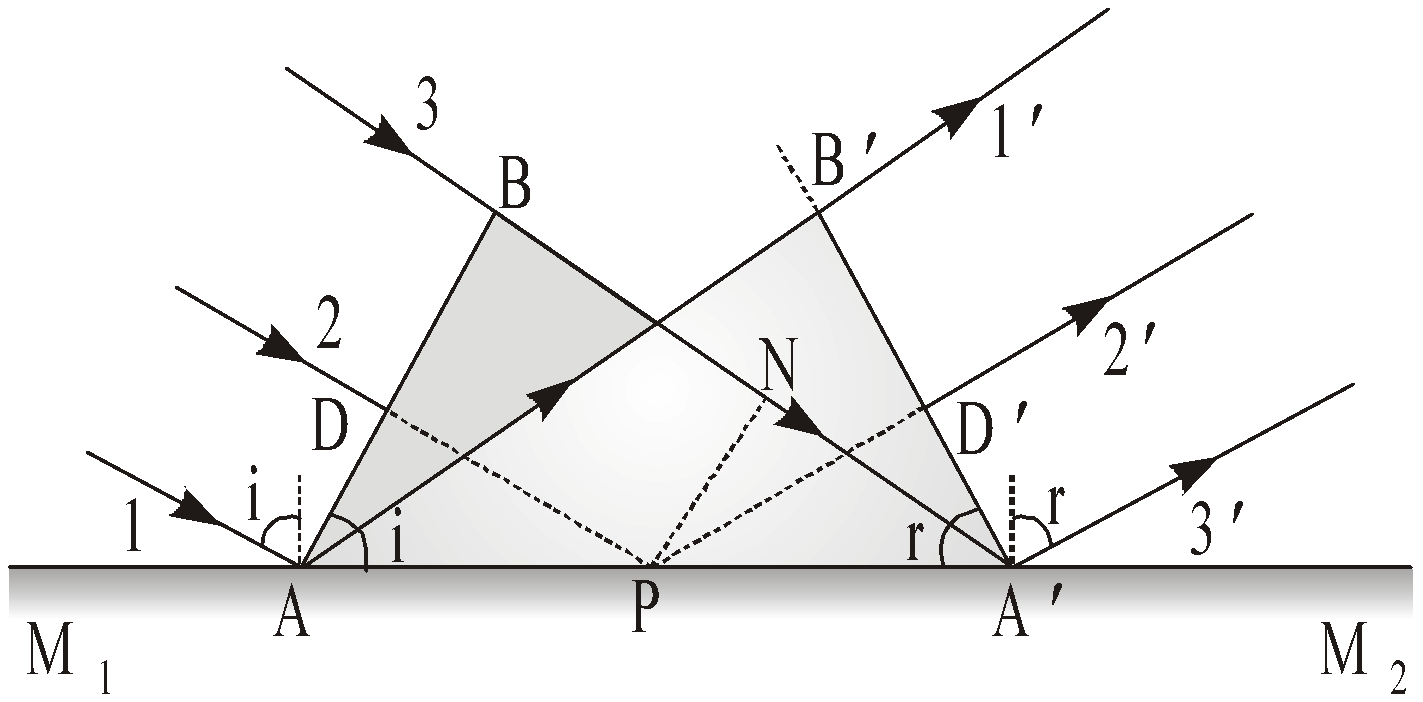
REFRACTION ON THE BASIS OF WAVE THEORY
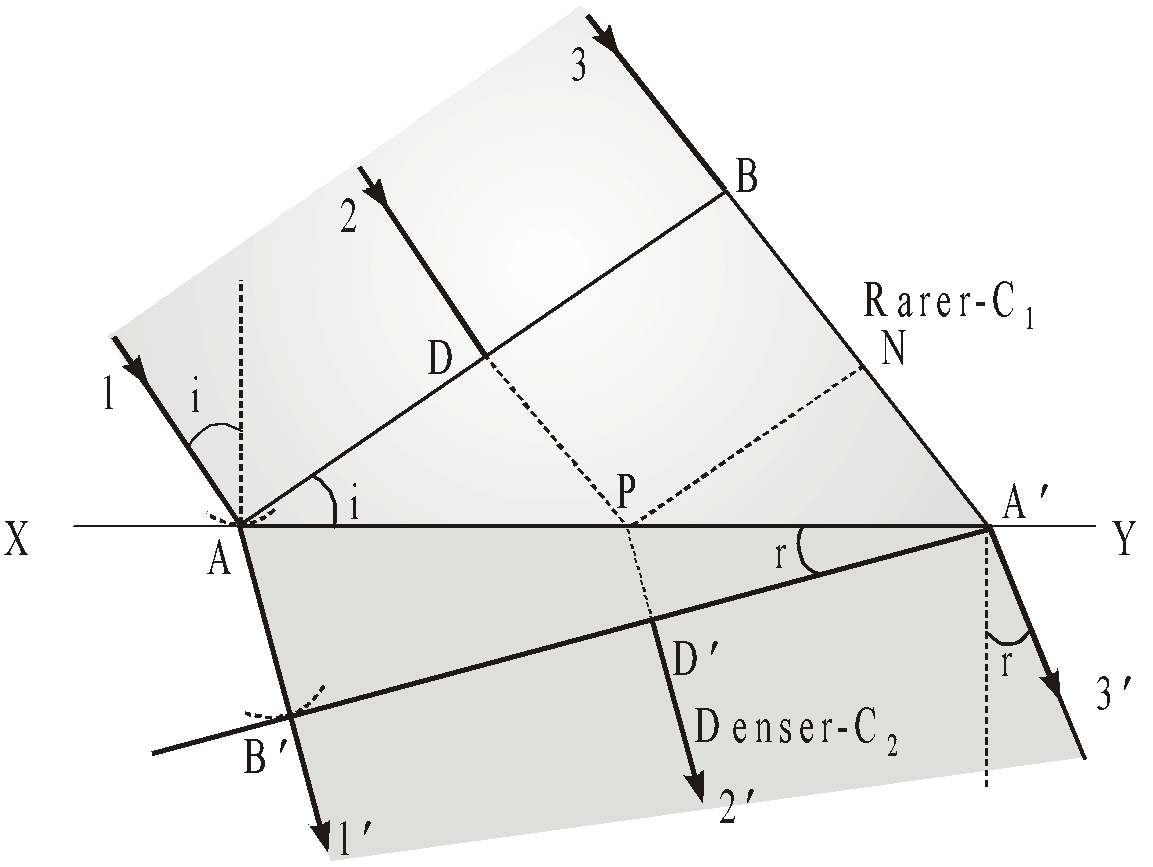
- In 1873, Maxwell showed that light is an electromagnetic wave i.e. it propagates as transverse non-mechanical wave at speed c in free space given by
- There are some phenomenon of light like photoelectric effect, Compton effect, Raman effect etc. which can be explained only on the basis of particle nature of light.
- Light shows the dual nature i.e. particle as well as wave nature of light. But the wave nature and particle nature both cannot be possible simultaneously.
- Interference and diffraction are the two phenomena that can be explained only on the basis of wave nature of light.
INTERFERENCE OF LIGHT WAVES AND YOUNG’S DOUBLE SLIT EXPERIMENT
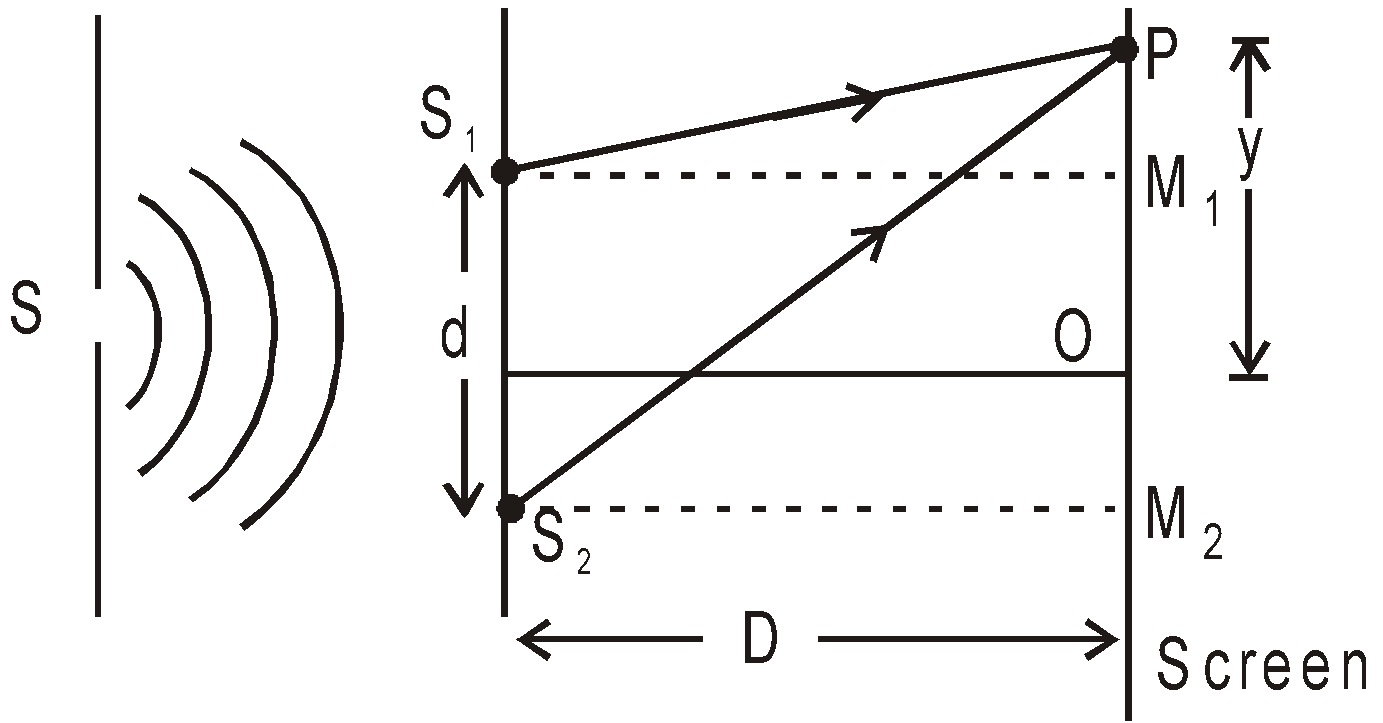
 ….(3)
….(3)
(A) CONDITIONS FOR MAXIMUM & MINIMUM INTENSITY
(B) POSITION OF FRINGE
(C) SPACING OR FRINGE WIDTH
(D) CONDITIONS FOR SUSTAINED INTERFERENCE
- The two sources should be coherent i.e. they should have a constant phase difference between them.
- The two sources should give light of same frequency (or wavelength).
- If the interfering waves are polarized, then they must be in same state of polarization.
(E) CONDITIONS FOR GOOD OBSERVATION OF FRINGE
- The distance between two sources i.e. d should be small.
- The distance of screen D from the sources should be quite large.
- The two interfering wavefronts must intersect at a very small angle.
(F) CONDITIONS FOR GOOD CONTRAST OF FRINGE
- Sources must be monochromatic i.e. they emit waves of single wavelength.
- The amplitude of two interfering waves should be equal or nearly equal.
- Both sources must be narrow.
- As Intensity I is directly proportional to the square of amplitude, hence Intensity of resultant wave at P,

- Angular fringe-width

- The width of all interference fringes are same. Since fringe width β is proportional to λ, hence fringes with red light are wider than those for blue light.
- If the interference experiment is performed in a medium of refractive index μ instead of air, the wavelength of light will change from λ to
 .
.
- If a transparent sheet of refractive index μ and thickness t is introduced in one of the paths of interfering waves, then due to its presence optical path will become μt instead of t. Due to this a given fringe from present position shifts to a new position. So the lateral shift of the fringe,
- In Young’s double slit experiment (coherent sources in phase): Central fringe is a bright fringe. It is on the perpendicular bisector of coherent sources. Central fringe position is at a place where two waves having equal phase superpose.
- Young’s experiment with the white light will give white central fringe flanked on either side by coloured bands.
COHERENCE
TEMPORAL COHERENCE
- The duration of this transition is about 10–9 to 10–10 sec. Thus the emitted wave remains sinusoidal for this much time. This time is known as coherence time (
 ).
). - Definite phase relationship is maintained for a length
 called coherence length.
called coherence length.
- The spectral lines width
 is related to coherence length L and coherence time τc.
is related to coherence length L and coherence time τc.
SPATIAL COHERENCE
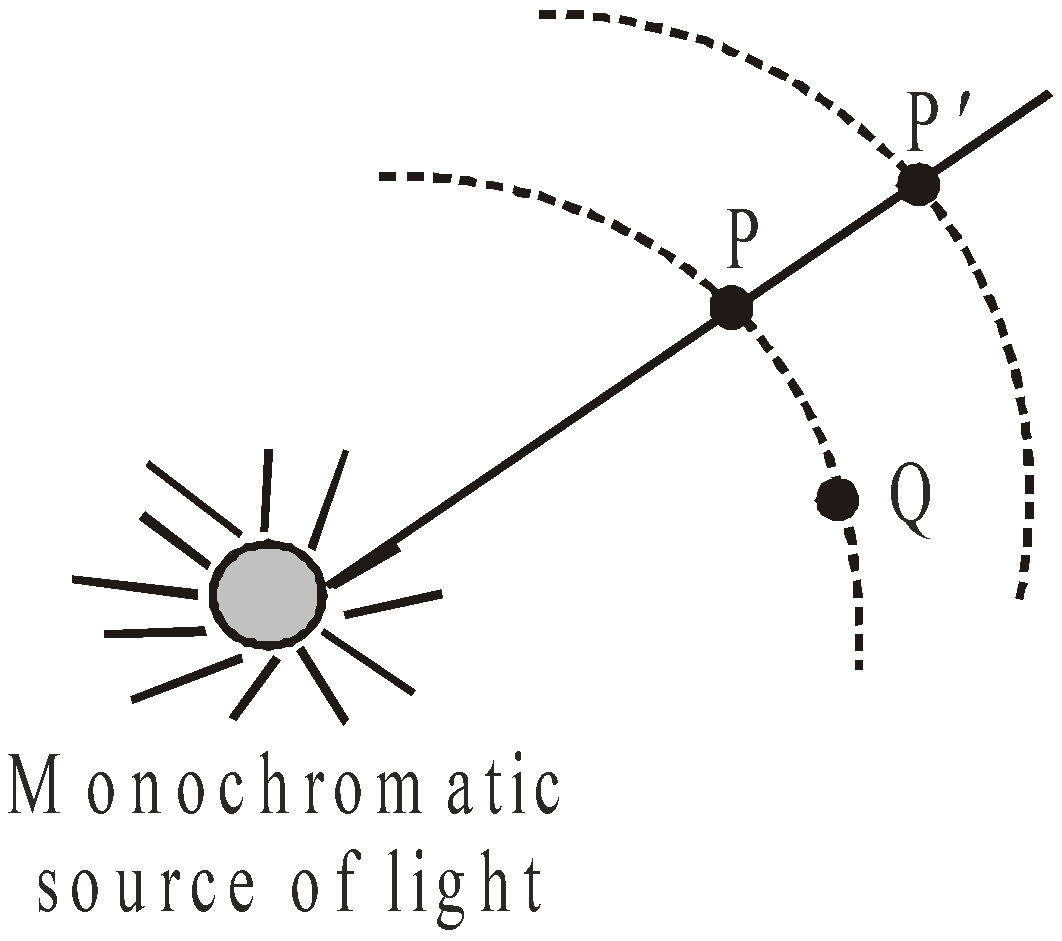
METHODS OF OBTAINING COHERENT SOURCES
- By division of wavefront
- By division of amplitude.
INCOHERENCE OF TWO CONVENTIONAL LIGHT SOURCES
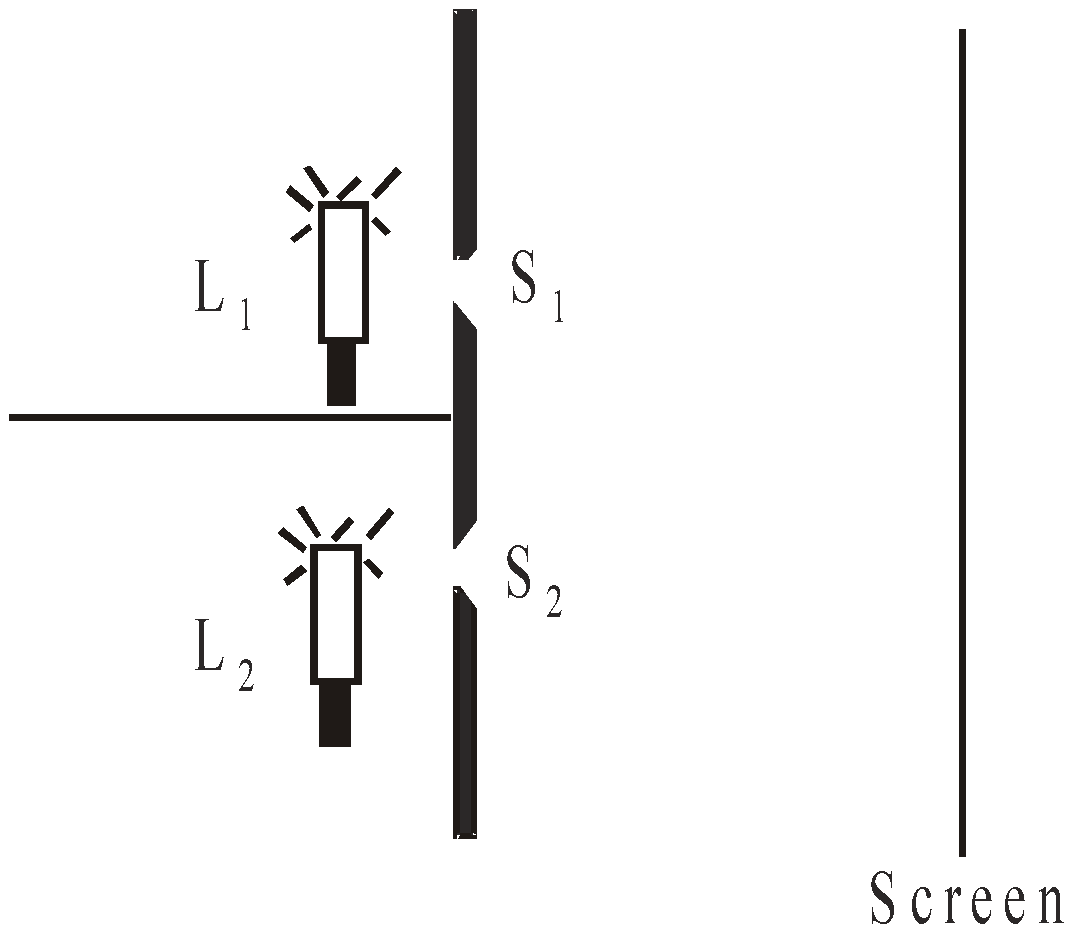
LLOYD’S MIRROR
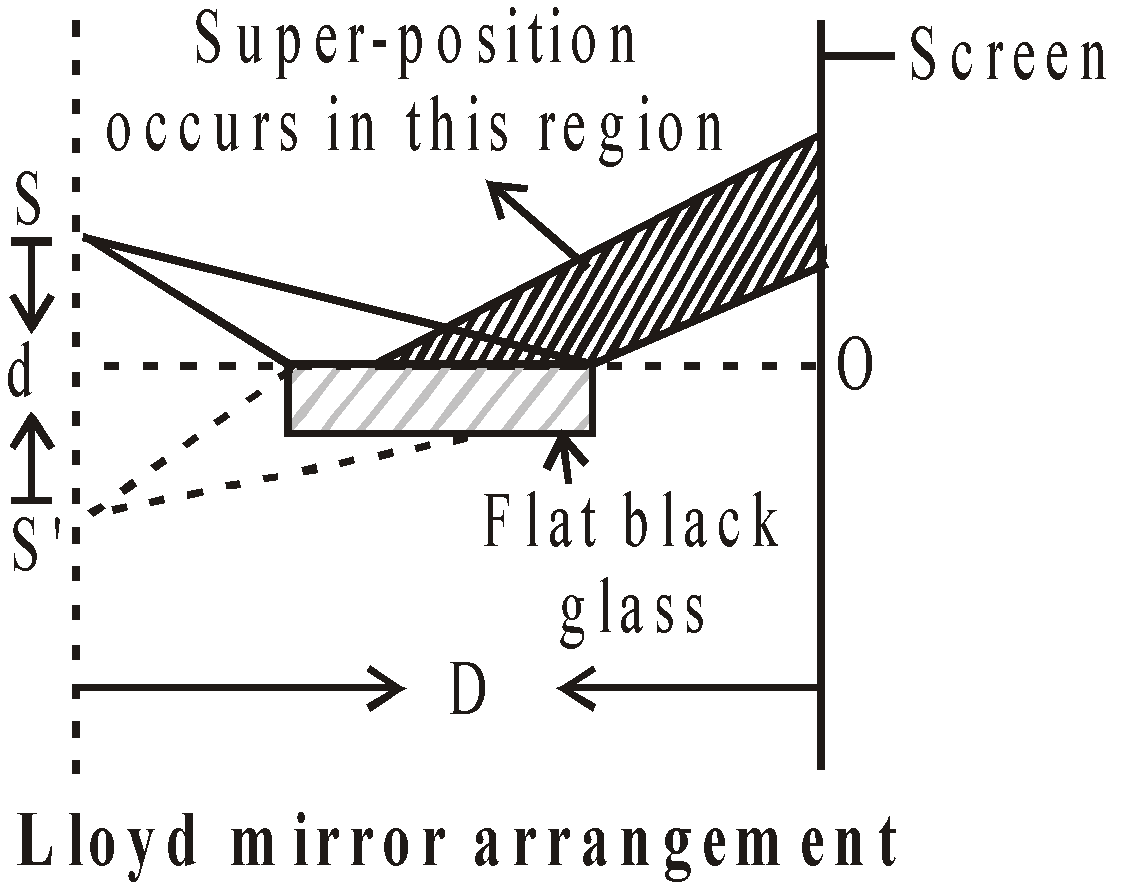
- If screen is moved so that, point O touches the edge of glass plate, the geometrical path difference for two wave trains is zero. The phase change of π radian on reflection at denser medium causes a dark fringe to be formed.
- The fringe width remains unchanged on introduction of transparent film.
- If the film is placed in front of upper slit S1, the fringe pattern will shift upwards. On the other hand if the film is placed in front of lower slit S2, the fringe pattern shifts downwards.
- This interference pattern is frequently seen in a ripple tank when one uses a wave train to demonstrate the law of reflection.
- In this case, fringe width

INTERFERENCE IN THIN FILMS
- reflected light
- transmitted light
INTERFERENCE DUE TO REFLECTED LIGHT
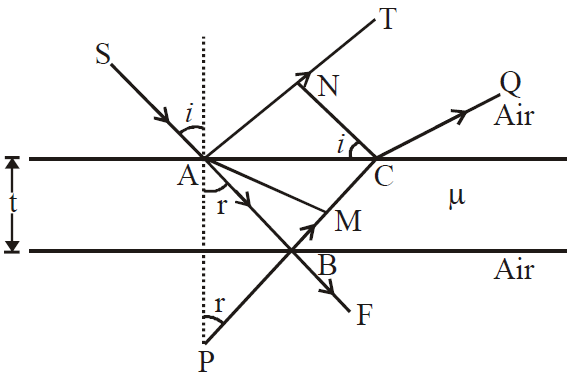
- If
 , where n = 0,1,2, …………..then constructive interference takes place and the film appears bright.
, where n = 0,1,2, …………..then constructive interference takes place and the film appears bright. - If
 , where n = 0, 1, 2, 3,………… then destructive interference takes place and the film appears dark.
, where n = 0, 1, 2, 3,………… then destructive interference takes place and the film appears dark.
INTERFERENCE DUE TO TRANSMITTED LIGHT
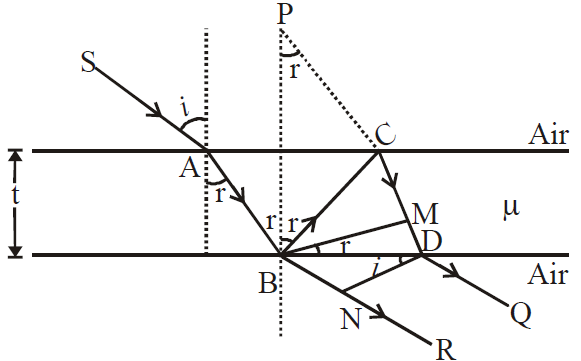
NEWTON’S RINGS

NEWTON’S RINGS BY REFLECTED LIGHT
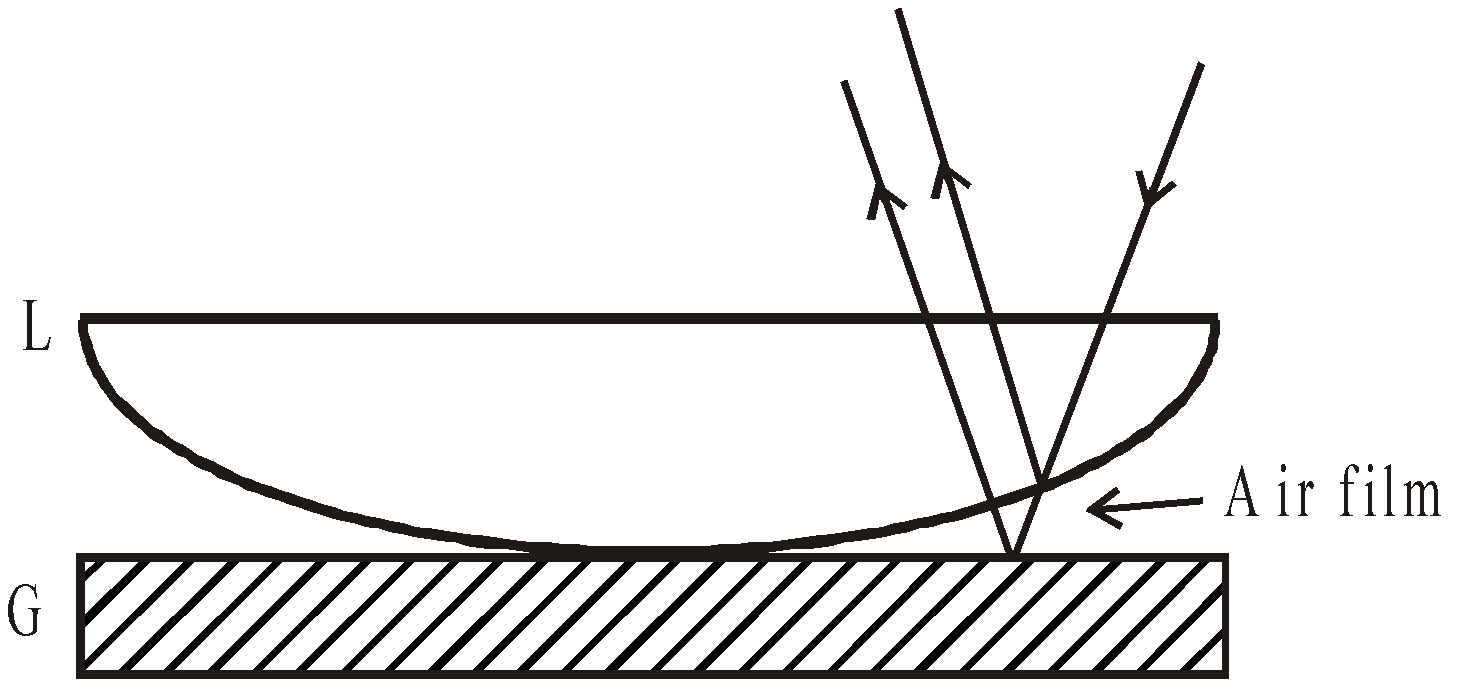
where R = radius of curvature of lens.
- The centre is dark and alternately dark and bright rings are produced.
- While counting the order of the dark rings 1, 2, 3, etc. the central ring is not counted. Therefore,
NEWTON’S RINGS BY TRANSMITTED LIGHT
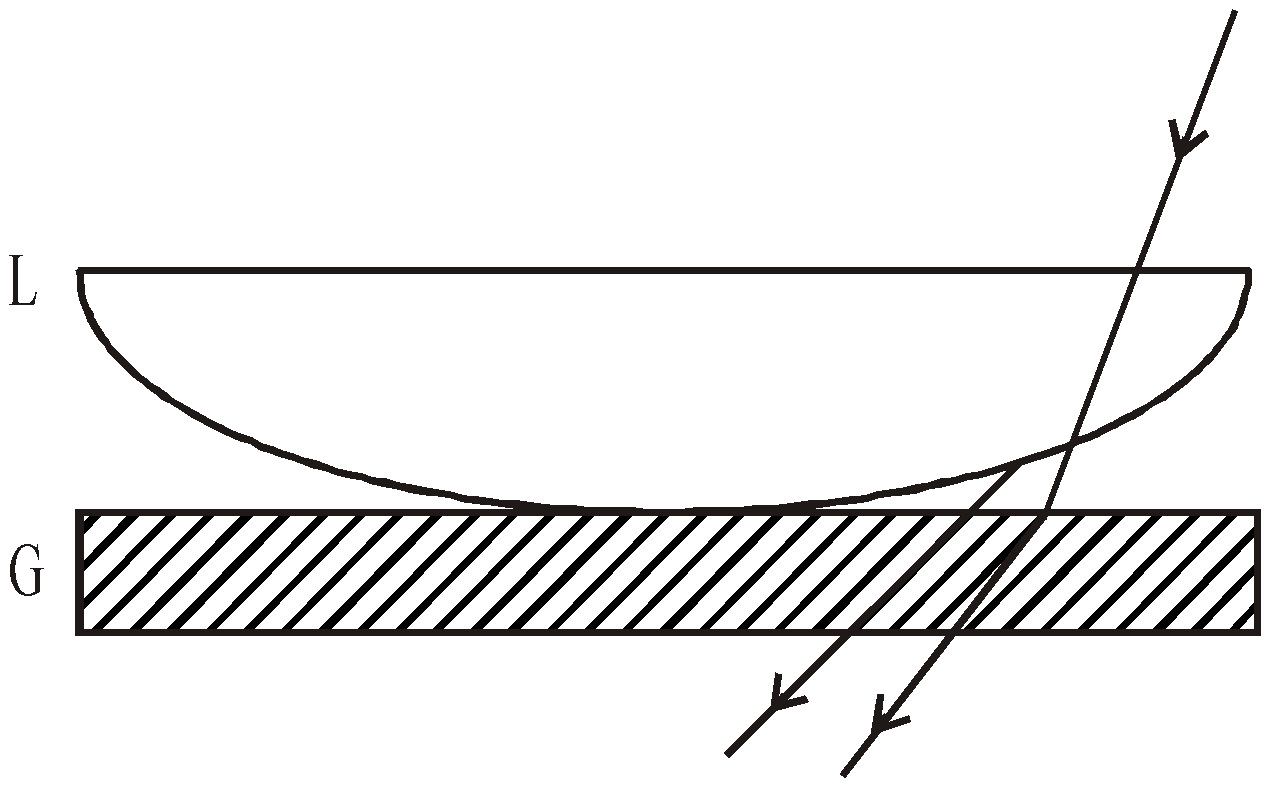
- The centre is bright and alternately bright and dark rings are obtained.
- The ring pattern due to reflected light is just opposite to that of transmitted light.
- If Dn and Dn + m be the diameters of n th and (n + m)th dark rings then the wavelength of light used is given by
- If Dn = diameter of nth dark ring when air is present between the glass plate and the lens
DIFFRACTION
FRAUNHOFER DIFFRACTION BY SINGLE SLIT
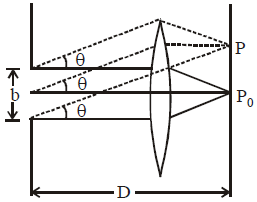
- The points of the maximum intensity lie nearly midway between the successive minima. The amplitude E0‘ of the electric field at a general point P is
- The graph for the variation of intensity as a function of sinθ is as follows :
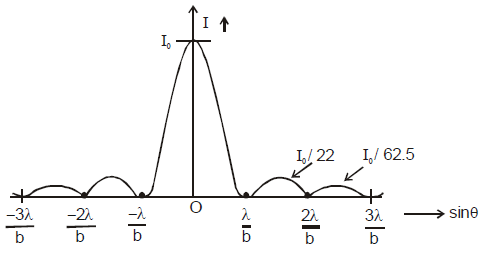
- The width of the central maxima is
 and angular width of central maxima is
and angular width of central maxima is .
.
FRAUNHOFER DIFFRACTION BY A CIRCULAR APERTURE
- The 1st dark ring is formed by the light diffracted from the circular aperture at an angle θ with the axis where
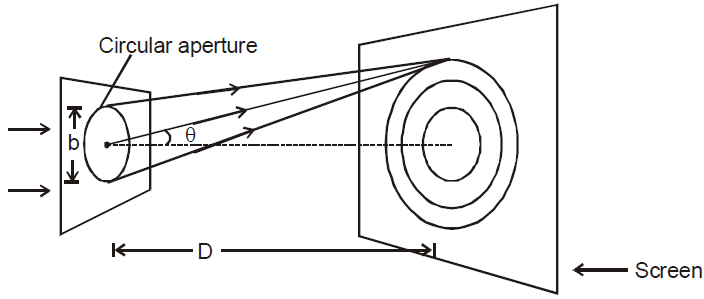
- If the screen is at a distance D (D >> b) from the circular aperture, the radius of the 1st dark ring is,

- If the light transmitted by the hole is converged by a converging lens at the screen placed at the focal plane of the lens, the radius of the 1st dark ring is

DIFFERENCE BETWEEN INTERFERENCE AND DIFFRACTION OF LIGHT

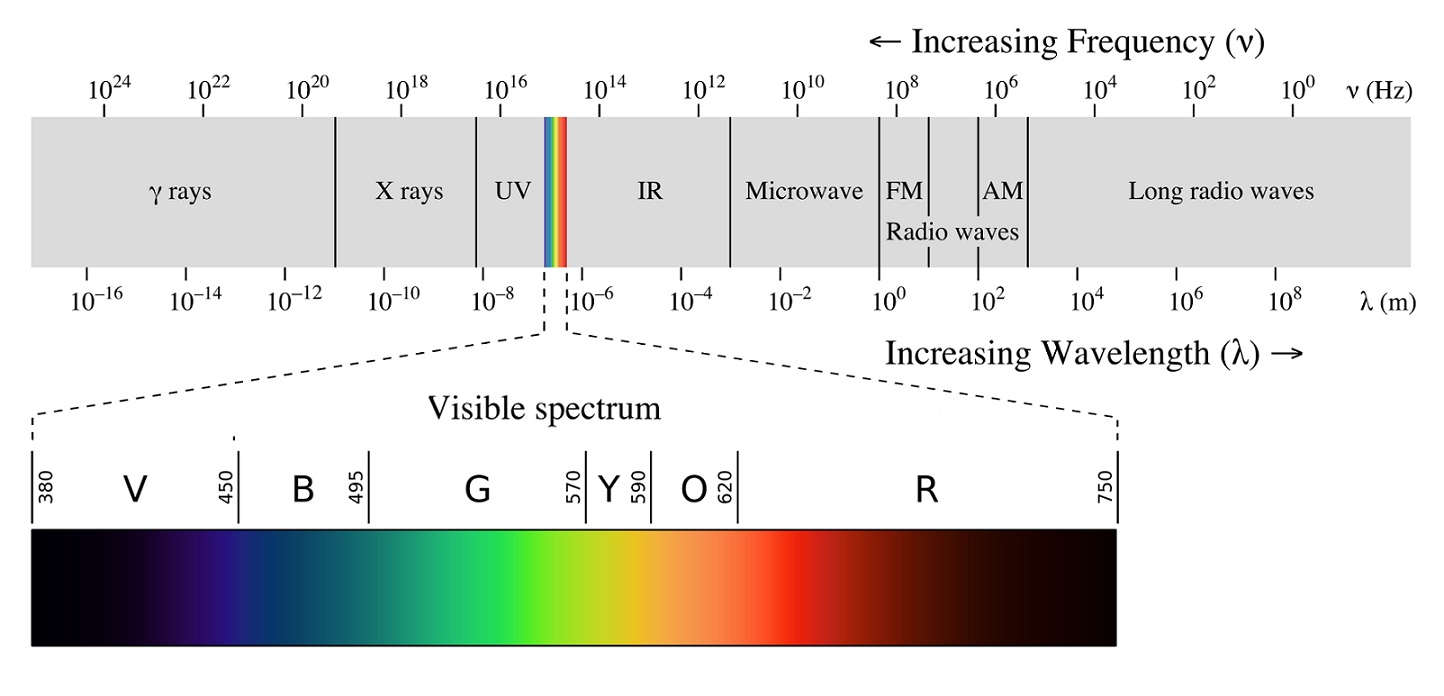
POLARISATION
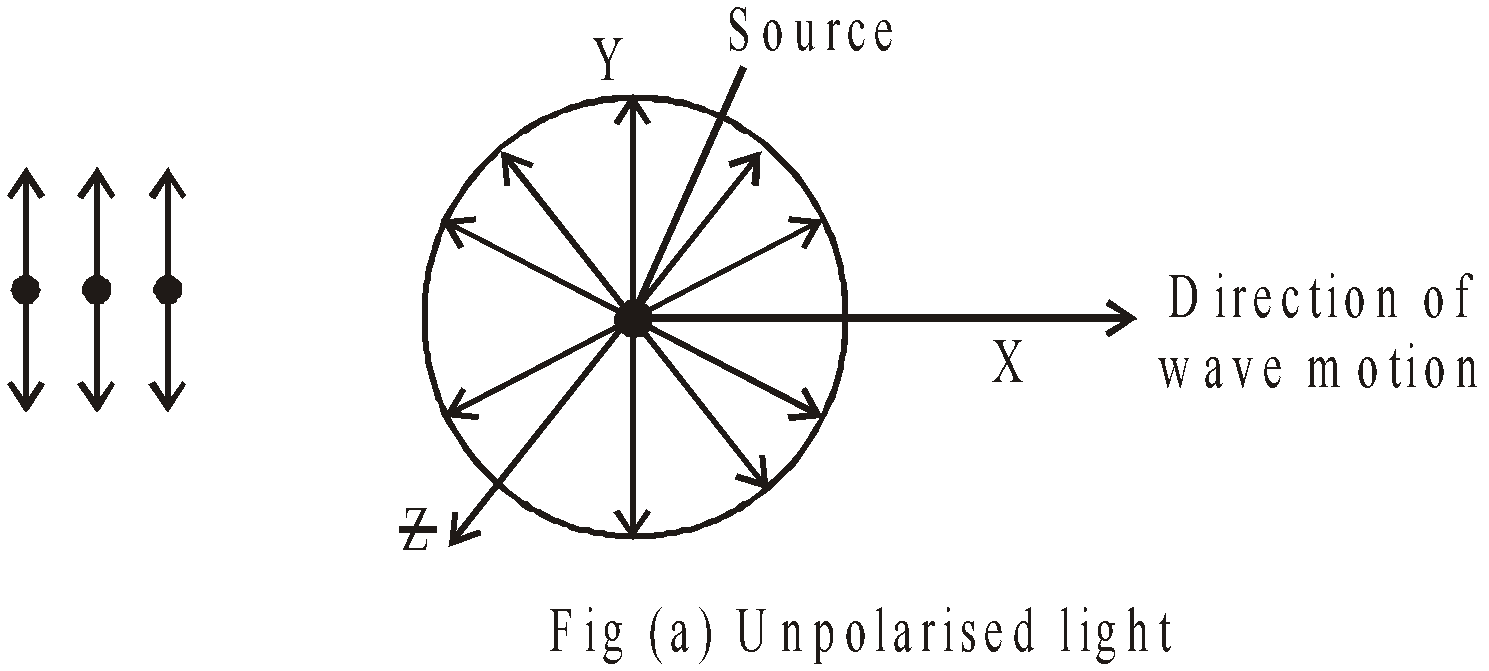
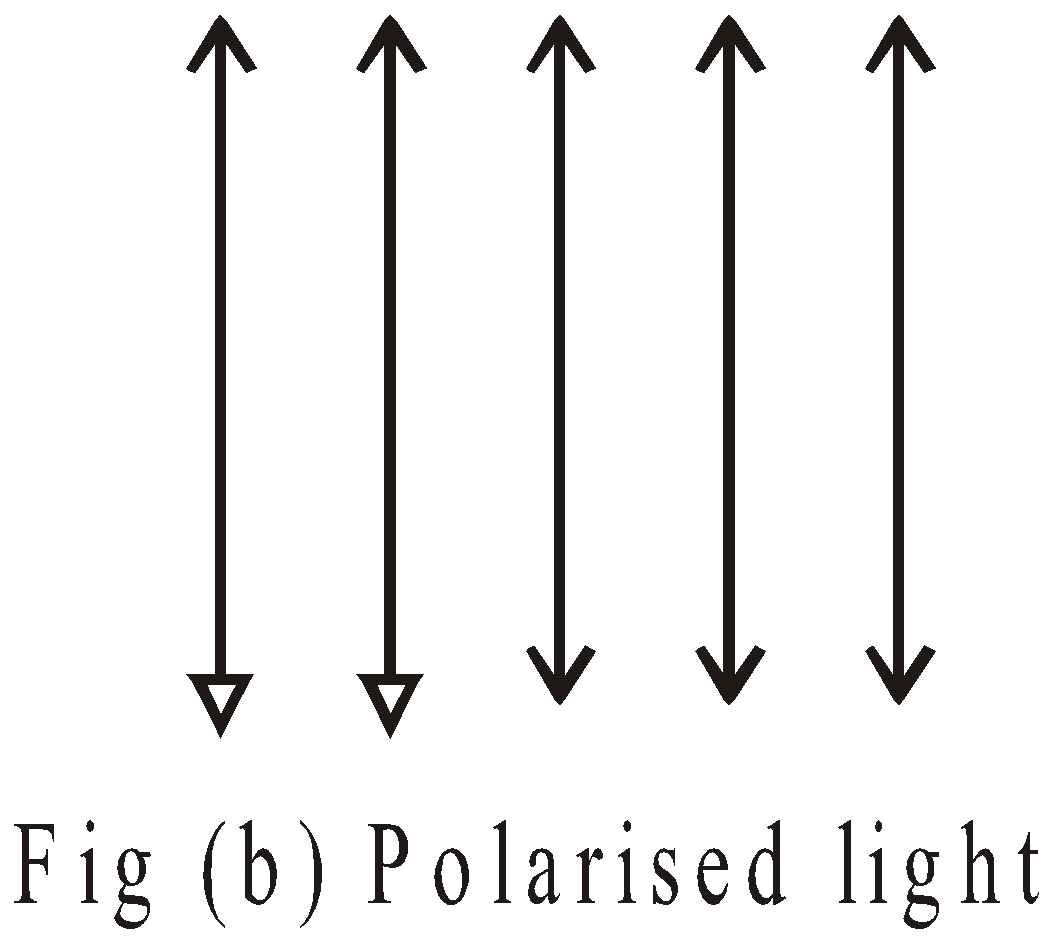
POLARIZATION BY REFLECTION (BREWSTER’S LAW)
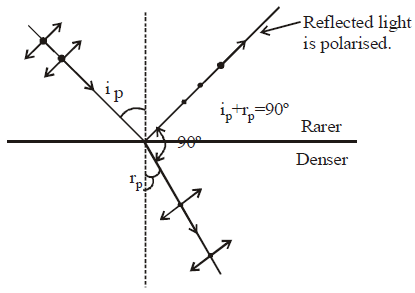
LAW OF MALUS
- Plane polarized : oscillating electric field is in a single plane.
- Circularly polarized : tip of oscillating electric field describes a circle.
- Elliptically polarized : tip of oscillating electric field describes an ellipse.
RESOLVING POWER OF AN OPTICAL INSTRUMENT
DOPPLER’S EFFECT FOR LIGHT WAVES
WAVES
WAVE MOTION
- Mechanical waves : These waves require material medium for their propagation. For example : sound waves, waves in stretched string etc.
- Non-mechanical waves or electromagnetic waves : These waves do not require any material medium for their propagation. For example : light waves, x-rays etc.
- Transverse waves : In the transverse wave, the particles of medium oscillate in a direction perpendicular to the direction of wave propagation. Waves in stretched string, waves on the water surface are transverse in nature.
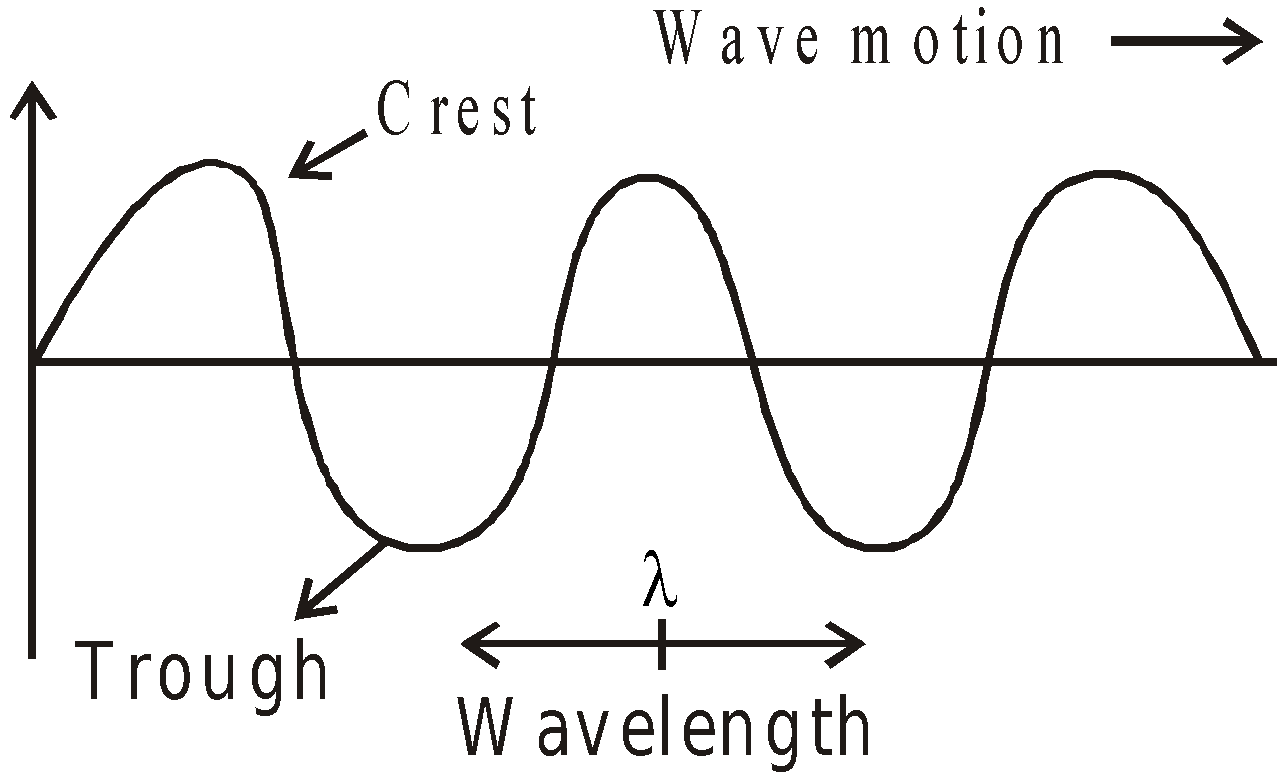
- Longitudinal waves : In longitudinal waves particles of medium oscillate about their mean position along the direction of wave propagation.
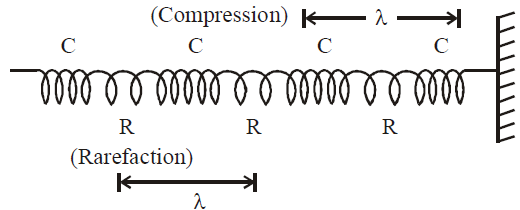
EQUATION OF A HARMONIC WAVE


- Phase difference of 2π radian is equivalent to a path difference λ and a time difference of period T.
- Phase difference =
 × path difference
× path difference

- Phase difference =
 × time difference
× time difference

- Time difference =
 × path difference
× path difference 

Longitudinal Waves
In a longitudinal wave the particle displacement is parallel to the direction of wave propagation. The animation at right shows a one-dimensional longitudinal plane wave propagating down a tube. The particles do not move down the tube with the wave; they simply oscillate back and forth about their individual equilibrium positions. Pick a single particle and watch its motion. The wave is seen as the motion of the compressed region (ie, it is a pressure wave), which moves from left to right.
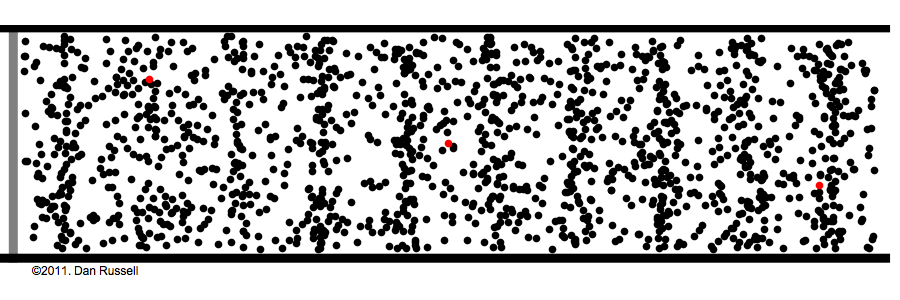
The second animation at right shows the difference between the oscillatory motion of individual particles and the propagation of the wave through the medium. The animation also identifies the regions of compression and rarefaction.
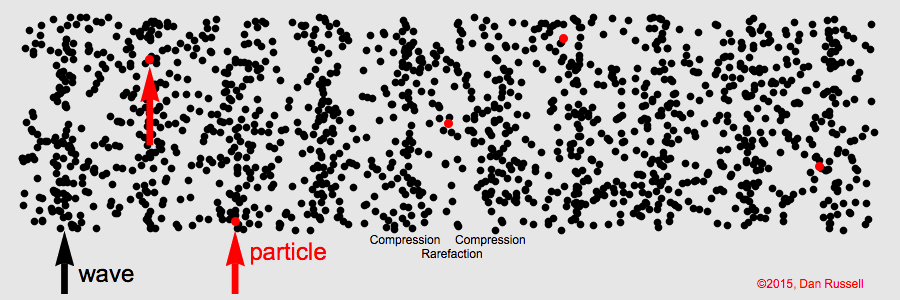
The P waves (Primary waves) in an earthquake are examples of Longitudinal waves. The P waves travel with the fastest velocity and are the first to arrive
Transverse Waves
In a transverse wave the particle displacement is perpendicular to the direction of wave propagation. The animation below shows a one-dimensional transverse plane wave propagating from left to right. The particles do not move along with the wave; they simply oscillate up and down about their individual equilibrium positions as the wave passes by. Pick a single particle and watch its motion.
The S waves (Secondary waves) in an earthquake are examples of Transverse waves. S waves propagate with a velocity slower than P waves, arriving several seconds later.

Standing and travelling waves
The main differences between a standing wave and a travelling wave are summarised below.
- In a travelling wave, the disturbance produced in a region propagates with a definite velocity but in a standing wave, it is confined to the region where it
is produced. - In a travelling wave, the motion of all the particles are similar in nature. In a standing wave, different particles move with different amplitudes.
- In a standing wave, the particles at nodes always remain in rest. In travelling waves, there is no particle which always remains in rest.
- In a standing wave, all the particles cross their mean positions together. In a travelling wave, there is no instant when all the particles are at the mean positions together.
- In a standing wave, all the particles between two successive nodes reach their extreme positions together, thus moving in phase. In a travelling wave, the phases of nearby particles are always different.
- In a travelling wave, energy is transmitted from one region of space to other but in a standing wave, the energy of one region is always confined in that region.
SPEED OF TRANSVERSE WAVES
- The speed of transverse waves in solid is given by

- The speed of transverse waves on stretched string is given by

SPEED OF LONGITUDINAL WAVES


are above our range of hearing.
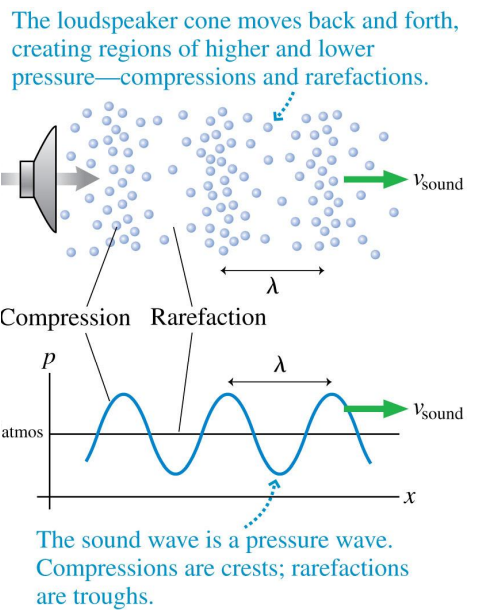
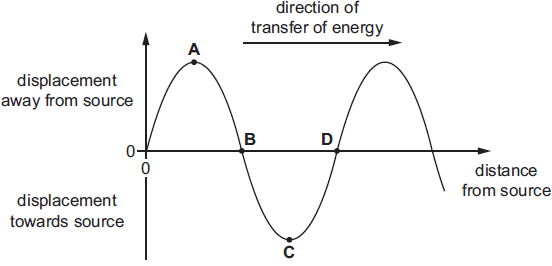
Parameters of water waves

SPEED OF SOUND IN A GAS

POWER AND INTENSITY OF WAVE MOTION
PRINCIPLE OF SUPERPOSITION OF WAVES
INTERFERENCE OF WAVES
- The ratio of maximum and minimum intensities in any interference wave form.

- Average intensity of interference in wave form :
Put the value of Imax and Imin
- Condition of maximum contrast in interference wave form
- For a wave, v = f λ
- The wave velocity of sound in air

- Particle velocity is given by
 . It changes with time. The wave velocity is the velocity with which disturbances travel in the medium and is given by
. It changes with time. The wave velocity is the velocity with which disturbances travel in the medium and is given by .
. - When a wave reflects from denser medium the phase change is π and when the wave reflects from rarer medium, the phase change is zero.
- In a tuning fork, the waves produced in the prongs is transverse whereas in the stem is longitudinal.
- A medium in which the speed of wave is independent of the frequency of the waves is called non-dispersive. For example air is a non-dispersive medium for the sound waves.
- Transverse waves can propagate in medium with shear modulus of elasticity e.g., solid whereas longitudinal waves need bulk modulus of elasticity hence can propagate in all media solid, liquid and gas.
ENERGY TRANSPORTED BY A HARMONIC WAVE ALONG A STRING

BEATS

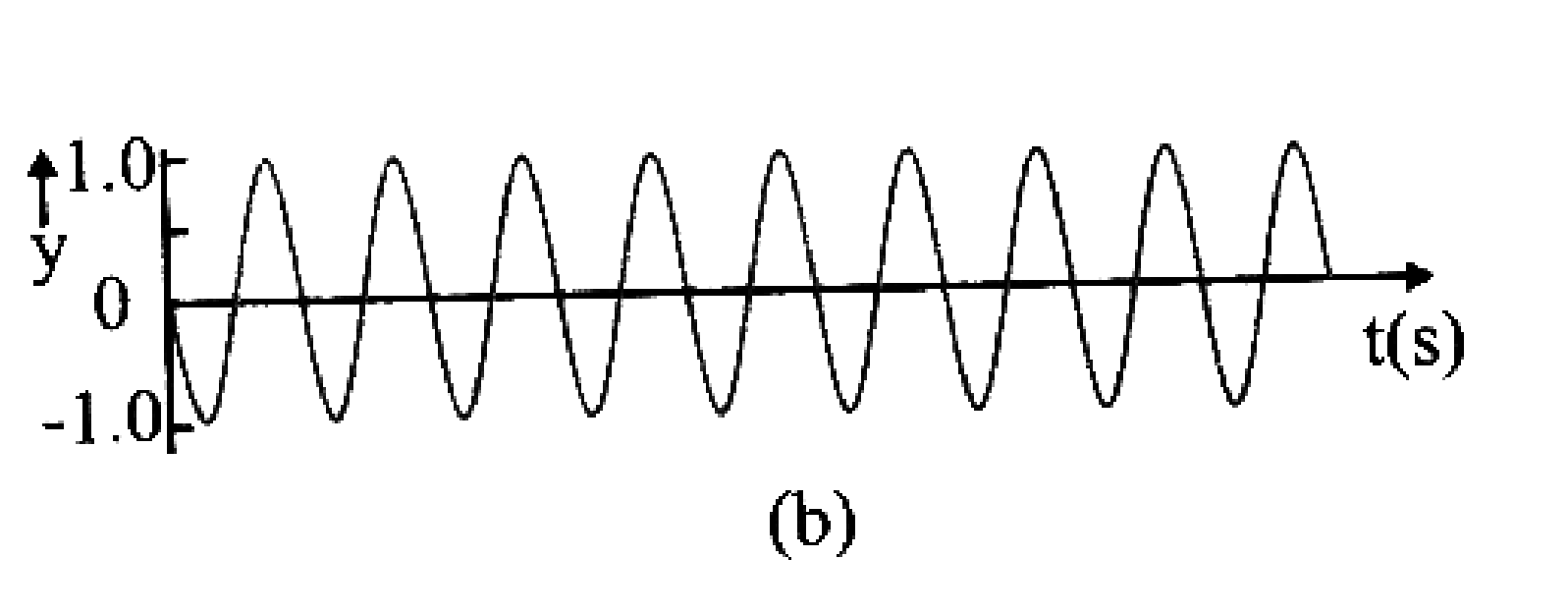
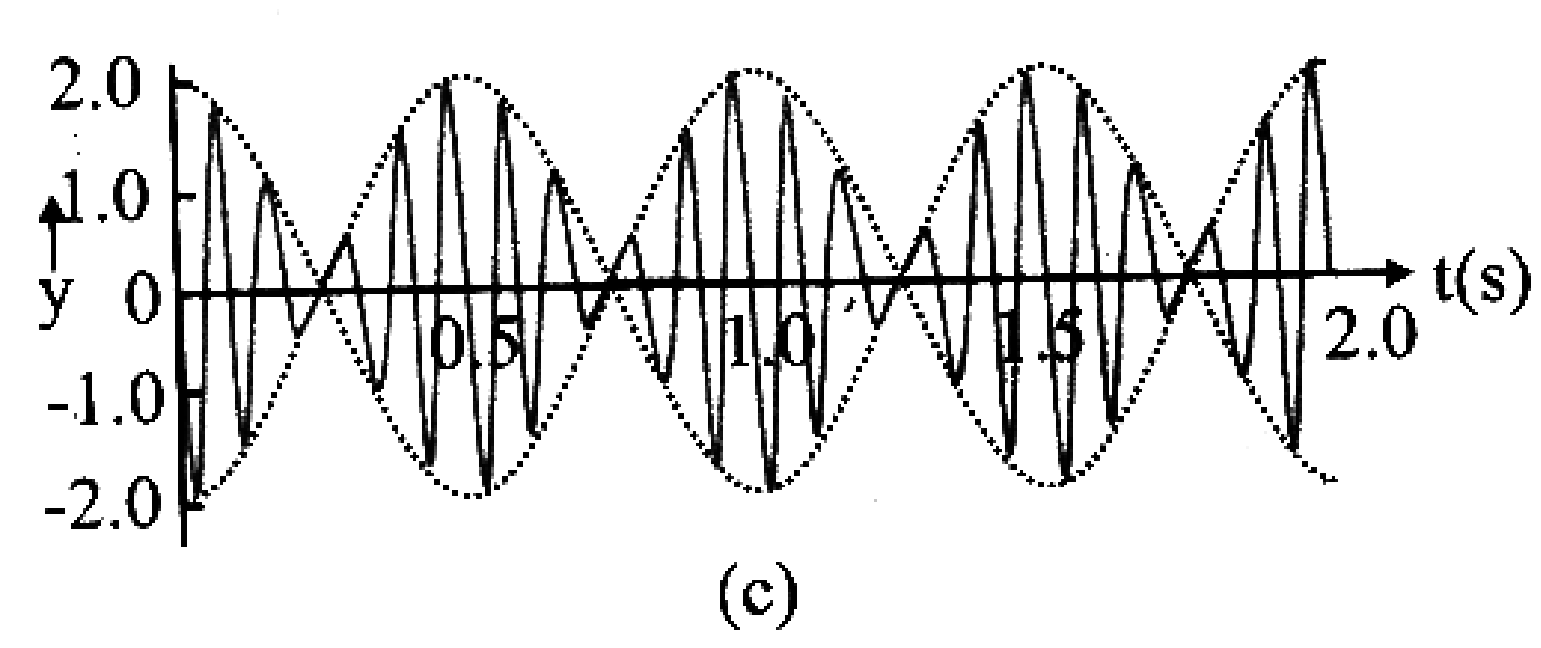
- Abeat = 2A cos 2πnAt, amplitude of resultant wave varies periodically as frequency
- Since intensity is proportional to amplitude i.e.,


FILING/LOADING A TUNING FORK
- When a tuning fork of frequency ν produces Δν beats per second with a standard tuning fork of frequency ν0, then

- If the beat frequency decreases or reduces to zero or remains the same on loading the unknown fork with a little wax, then

DOPPLER EFFECT
- When source is in motion and observer at rest
- when source moving towards observer
- when source moving away from observer
- When source is at rest and observer in motion
- when observer moving towards source
- when observer moving away from source and
V0 = velocity of observer.
- When source and observer both are in motion
- If source and observer both move away from each other.
- If source and observer both move towards each other.
- When the wind blows in the direction of sound, then in all above formulae V is replaced by (V + W) where W is the velocity of wind. If the wind blows in the opposite direction to sound then V is replaced by (V – W).
- The motion of the listener causes change in number of waves received by the listener and this produces an apparent change in frequency.
- The motion of the source of sound causes change in wavelength of the sound waves, which produces apparent change in frequency.
- If a star goes away from the earth with velocity v, then the frequency of the light emitted from it changes from ν to ν’.
If wavelength of the observed waves decreases then the object from which the waves are coming is moving towards the listener and vice versa.
STATIONARY OR STANDING WAVES
- As = 0, when cos kx = 0 i.e., kx = π/2, 3π/2…………
i.e., x = λ/4, 3λ/4……………….[as k = 2π/λ]
- As is maximum, when cos kx is max
- The distance between node and antinode is λ/4 (see figure)
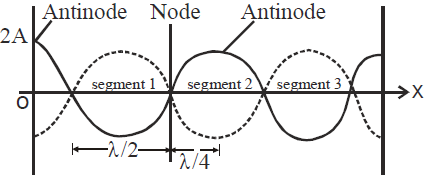
- When a string vibrates in one segment, the sound produced is called fundamental note. The string is said to vibrate in fundamental mode.
- The fundamental note is called first harmonic, and is given by
 , where v = speed of wave.
, where v = speed of wave. - If the fundamental frequency be
 then
then  ,
,  ,
,  … are respectively called second third, fourth … harmonics respectively.
… are respectively called second third, fourth … harmonics respectively. - If an instrument produces notes of frequencies
 …. where
…. where  ….., then
….., then  is called first overtone,
is called first overtone,  is called second overtone,
is called second overtone,  is called third overtone … so on.
is called third overtone … so on. - Harmonics are the integral multiples of the fundamental frequency. If ν0 be the fundamental frequency, then nν0 is the frequency of nth harmonic.
- Overtones are the notes of frequency higher than the fundamental frequency actually produced by the instrument.
- In the strings all harmonics are produced.
STATIONARY WAVES IN AN ORGAN PIPE

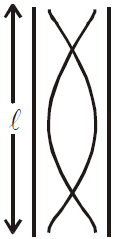
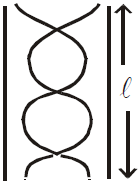
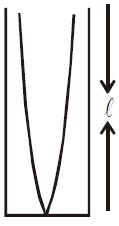

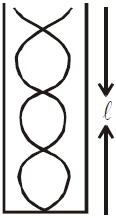
- For closed organ pipe : l is replaced by l + e where e = 0.3D, D is the diameter of the tube.
- For open organ pipe : l is replaced by l + 2e where e = 0.3D
RESONANCE TUBE
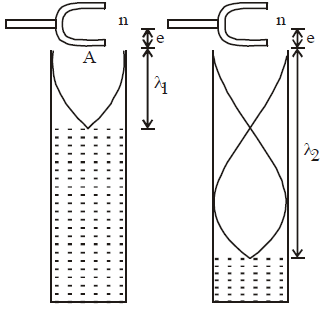
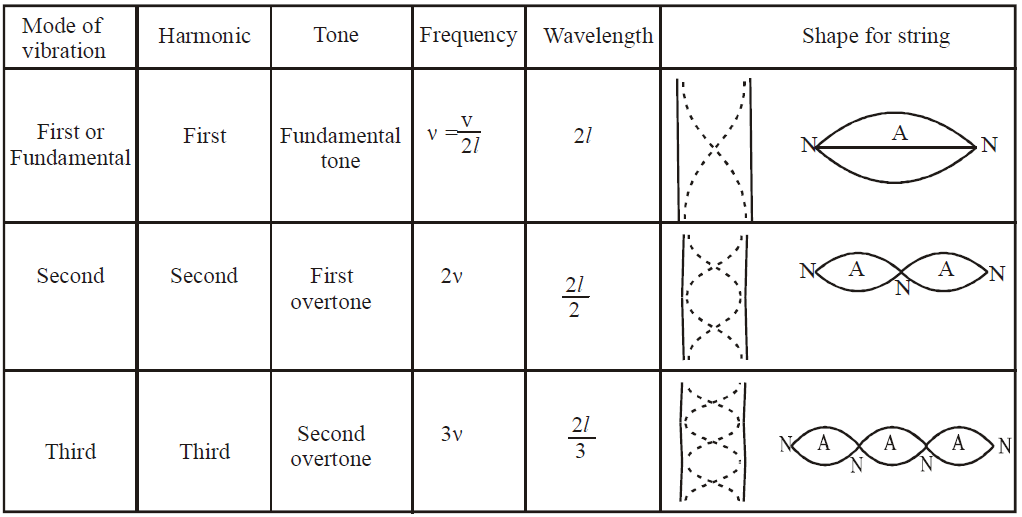
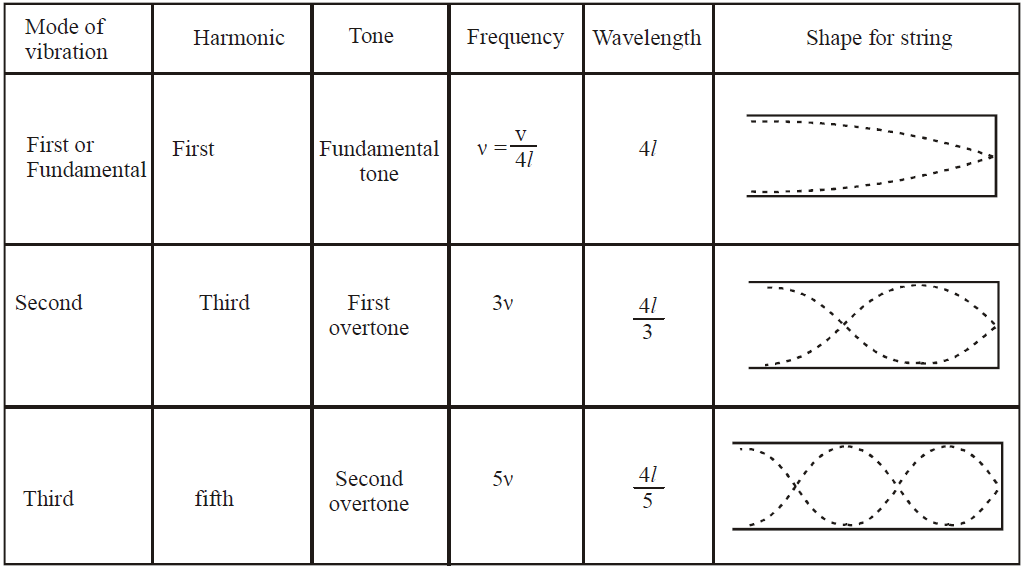
COMPARISON OF PROGRESSIVE (OR TRAVELLING) AND STATIONARY (OR STANDING) WAVE

COMPARATIVE STUDY OF INTERFERENCE, BEATS AND STATIONARY WAVE
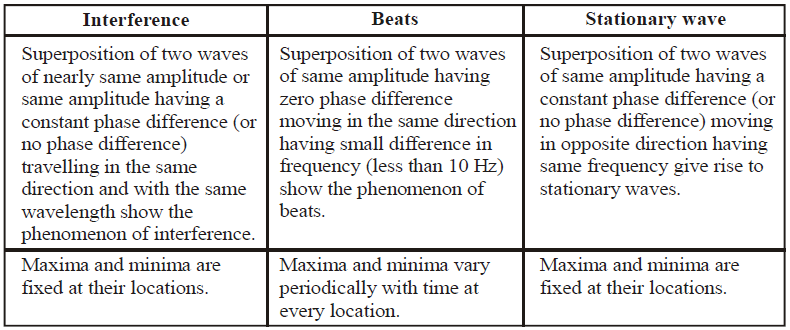
CHARACTERISTICS OF SOUND
- Pitch depends on frequency
- loudness depends on intensity
- quality depends on the number and intensity of overtones
ACOUSTICS
- Electro acoustics. This branch deals with electrical sound production with music.
- Musical acoustics. This branch deals with the relationship of sound with music.
- Architectural acoustics. This branch deals with the design and construction of buildings.
REVERBERATION
α1 , α2 …. are their respective absorption coefficient.
SHOCK WAVES
INTENSITY OF SOUND
LISSAJOUS FIGURES
- ratio of frequencies or time periods of two waves
- ratio of amplitude of two waves
- phase difference between two waves.
